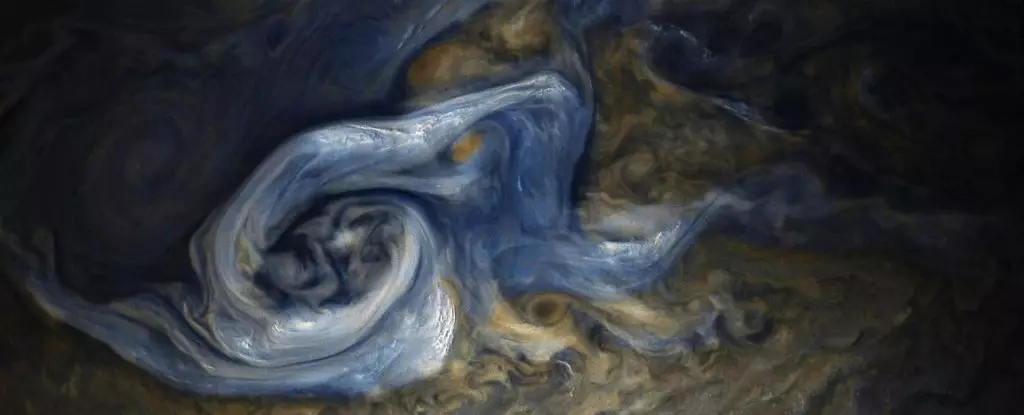Jupiter, the largest planet in our Solar System, has long fascinated astronomers with its stunning storms, swirling clouds, and enigmatic atmospheric phenomena. While Earth’s meteorological patterns are relatively easier to comprehend, Jupiter’s immense atmosphere presents a kaleidoscope of bewildering behaviors that often elude straightforward explanation. Recent research shines new light on one of these peculiar phenomena: the formation of “mushballs,” clusters of icy materials that fall from the planet’s towering storm clouds. This thunderous spectacle raises questions not just about Jupiter itself but also about the atmospheric dynamics of the entire Solar System.
The Science Behind Mushballs
The term “mushballs” might evoke playful imagery, but the science behind their creation is anything but frivolous. These bizarre objects are thought to consist of a mix of ammonia and water, forming during the intense electrical storms that characterize Jupiter’s atmosphere. Unlike the predictable rain of Earth, which falls as water droplets, mushballs present an intriguing twist: they are akin to slushy snow, with a texture that defies easy categorization. Recent findings from research led by planetary scientist Chris Moeckel at the University of California, Berkeley, propose that these mushballs might help explain the uneven distribution of ammonia throughout Jupiter’s atmosphere.
According to the research, massive storms can propel water vapor high into the atmosphere, where it mingles with ammonia gas. This unlikely partnership results in a unique cloud formation, where ammonia acts as an antifreeze—enabling these two substances to amalgamate under conditions not seen on Earth. This novel interaction contributes to the electrifying conditions of Jupiter’s storms, leading to the fascinating phenomenon of mushball formation.
Diving Deeper: The Role of Juno and Hubble
To substantiate these striking theories, scientists turned to data culled by the Juno spacecraft and the Hubble Space Telescope. Juno’s mission includes monitoring intense lightning storms, providing crucial insights into the temperatures and chemical compositions of Jupiter’s upper atmosphere. Hubble complemented these findings by mapping a spectrum of wavelengths, painting a comprehensive picture of the atmospheric structure. The combination of data from these two powerful instruments has allowed scientists to analyze weather phenomena that extend far beyond what is visible at the planet’s surface.
The researchers discovered that despite the seemingly chaotic weather patterns, much of Jupiter’s storms lie only a relatively shallow 10 to 20 kilometers below the cloud tops. However, certain storms reach much deeper layers of the troposphere, creating conditions conducive to the churn that produces mushballs. This revelation—that vertical temperature and pressure variations can significantly influence atmospheric composition—is a significant breakthrough in our understanding of gas giants.
Mushballs and the Quest for Answers
One of the most groundbreaking aspects of the mushball hypothesis is its capacity to explain previously puzzling observations regarding ammonia depletion in Jupiter’s atmosphere. Prior to this theory, scientists speculated about the potential loss of ammonia but lacked concrete evidence explaining the mechanism. With mushballs, the process becomes clearer: as the mushballs descend, they transport water and ammonia deep into the planet where they ultimately evaporate, depositing their chemical constituents. It’s a cycle of mixing and transport that could have profound implications for the understanding of atmospheric processes across various planetary bodies, not just those in our Solar System.
The formation of mushballs also necessitates specific environmental conditions that are exquisitely rare. The powerful updrafts that carry water high into the atmosphere must coincide with rapid mingling of ammonia and water vapor to create these curious, slushy aggregates. This delicate balance makes the understanding of mushballs not merely an academic exercise but an essential framework for interpreting other giant planets’ atmospheres, suggesting that similar phenomena may occur beyond Jupiter, potentially reshaping our knowledge of planetary atmospheres throughout the cosmos.
Implications for Future Research
The potential for mushballs to exist on other gas giants, such as Saturn, Uranus, and Neptune, pushes the boundaries of our current knowledge and hints at the interconnectedness of planetary atmospheres. As astronomers continue to explore the outer Solar System and beyond, the insights gleaned from studying Jupiter’s mushballs could catalyze a broader understanding of how diverse atmospheres evolve and behave under differing conditions.
In a world where much of our understanding stems from Earth-centric models, the findings regarding Jupiter’s mushball storms challenge scientists to rethink long-held theories about atmospheric chemistry and dynamic weather patterns. As new missions and technologies spring forth, the lessons learned from this fascinating ice-water-ammonia cocktail could transform not only our understanding of Jupiter but also the intricate tapestry of planetary atmospheres across the universe, shaping the future of planetary science in profound and unexpected ways.

